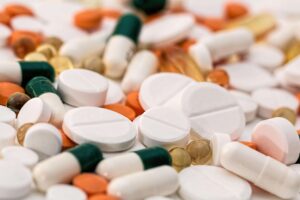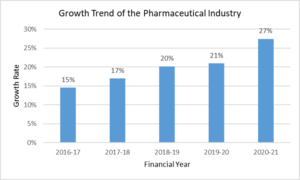
The pharmaceutical industry in Bangladesh has a very good success story. It had to go a long way to get to its current, esteemed place in both home and foreign markets. Currently, national pharmaceutical companies produce 97% of the nation’s medication needs locally.
Bangladesh’s pharmaceutical industry is growing quickly, and several businesses have already received certification for quality management and high-quality product manufacture from various international regulatory bodies, including the EU, TGA, UK, and MHRA. Furthermore, not many businesses are in the process of receiving US FDA approval.
According to the data provided by the Director General of the Drug Administration of Bangladesh (DGDA), there are 263 firms that manufacture allopathic drugs in Bangladesh. Of them, 209 are operating, 29 are not operating, and 25 have a suspended status. The country’s GDP benefits from pharmaceutical exports, and this contribution is positively increasing each year. Meanwhile, Bangladesh’s pharmaceutical industry has emerged as the second-largest potential source of foreign exchange earnings. Approximately thirty pharmaceutical companies have begun exporting their products as of right now.
Numerous smaller businesses are about to venture into heavily regulated international marketplaces. Considering its prior accomplishments, the industry has the capacity to become established in mass exportation.
Local Pharmaceutical Industry
One of the most advanced high-tech industries in Bangladesh’s economy is the pharmaceutical sector. Only 173 of the 210 licensed allopathic drug manufacturing facilities in the nation in 2000 were engaged in active production; the remaining facilities were either shut down independently or had their licenses for medications suspended for breaking drug laws or good manufacturing standards. Currently, there are over 300 pharmaceutical businesses in operation. The pharmaceutical sector produced over 5,600 brands of medications in various dosage forms. However, Bangladesh has roughly 37,700 license holders for retail drugs and 1,495 license holders for wholesale drugs.
The Drug Control Ordinance of 1982 was passed, which sped up the growth of this industry. The primary drivers of this progress are the pharmaceutical experts’ professional expertise, perspectives, and creative ideas. Owing to the industry’s recent growth, pharmaceuticals are being exported to international markets, notably those in Europe. Additionally, 97% of the local market’s overall medical needs are met by this industry. Previously, Bangladesh was not the producer of insulin, hormones, or anticancer medications, but these firms do make these. Prominent pharmaceutical corporations are growing their operations in an attempt to penetrate the international market. To strengthen this industry, a few new industries have emerged recently, equipped with advanced machinery and skilled workers.
Local Market Overview
The pharmaceutical market in Bangladesh is mostly a branded generic sector. Bangladeshi pharmaceutical companies have three options for selling their products: to the government and its public health care facilities, to private sector pharmacies, or to foreign organizations that have operations in Bangladesh (like UNICEF).
The pharmaceutical sector in Bangladesh is primarily controlled by domestic producers. Local businesses enjoy a market share of approximately 97% of Bangladesh’s entire pharmaceutical market, whereas MNCs have a relatively small market share. All ten of the pharmaceutical companies ranked highest in Bangladesh are indigenous businesses. The biggest two local producers, Square and Incepta Pharma, together hold a market share of more than 30% of the nation’s whole pharmaceutical industry.
Since its founding in 1972, the Bangladesh Association of Pharmaceutical Industries (BAPI) has played a crucial role in defining the sector. Large, medium, small, domestic, and international businesses make up the association’s membership, which collectively produces 97% of the nation’s pharmaceutical output.

Top Ten Pharmaceuticals
| Sl. No. | Name of the Company | Market Share (%) | Growth (%) |
| 01 | Square | 19.4 | 12.55 |
| 02 | Incepta Pharma | 10.02 | 11.84 |
| 03 | Beximco | 8.82 | 8.04 |
| 04 | Opsonin Pharma | 5.21 | 4.77 |
| 05 | Renata | 4.97 | 8.75 |
| 06 | Eskayef | 4.47 | 4.28 |
| 07 | Aristopharma | 4.31 | 11.37 |
| 08 | ACI | 4.19 | 8.69 |
| 09 | Acme | 3.89 | 5.76 |
| 10 | Drug International | 3.86 | 10.51 |
Medicine Exporting Scenario of Bangladesh
The pharmaceutical industry in Bangladesh exports a vast array of pharmaceutical products, encompassing all main therapeutic classes and dosage forms, to 79 countries, along with active pharmaceutical ingredients (APIs). In addition to standard forms such as tablets, capsules, and syrups, Bangladesh also exports high-tech specialized goods that are well-received by medical professionals, chemists, patients, and regulatory bodies in all importing countries. Examples of these goods include HFA inhalers, CFC inhalers, suppositories, nasal sprays, injectables, IV infusions, and more. They have approved Bangladesh’s product presentation and packaging, which is on par with any international standard.
Bangladesh started exporting drugs around the late 1980s. In FY 2011–12, Bangladesh’s pharmaceutical exports brought in US$48.3 million, or just 0.2% of the country’s overall revenues. Exports comprise only around 8 percent of the total production of the local Exports of pharmaceuticals from Bangladesh are still small in scale. Bangladesh’s pharmaceutical exports are still quite modest in quantity. But they are growing quickly; between 2002 and 2010, their compound annual growth rate was 26.1%. Exports to middle-income nations and the neighboring low-income nations of Myanmar, Afghanistan, and Nepal account for the majority of the growth. Exports to the EU have decreased since 2007, when they nearly surpassed $15 million USD.
Furthermore, anti-malaria medications account for a sizable portion of Bangladesh’s declared exports to the EU; however, EU-reported data does not corroborate the import of these medications. This most certainly represents purchases made by European aid organizations that are going to third nations. The majority of exports go to markets with low to moderate levels of pharmaceutical regulation. Accessing marketplaces that are even mildly regulated can be difficult and need a considerable amount of time to receive approval. For example, industry participants emphasized that it can take up to five years to receive market approval in Myanmar.
For more information,
Please contact us ….



